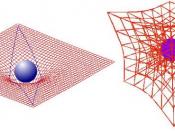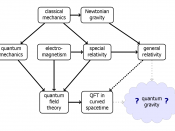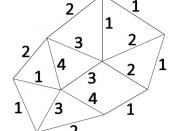The Graviton
In elementary school we were taught that gravity is a force that attracts all matter towards each other. It's the reason why the moon orbits the Earth, why the Earth orbits the sun, why the sun orbits the galactic center of the Milky Way, ect. But not until high school are we given any explanation as to what causes gravity. Many know Einstein as the "E=mc2 guy," and yet they don't even know what that means (the relation between energy and matter). So what does cause gravity?
In A brief History of Time, Stephen Hawking explains that Aristotle believed in four elements; earth, fire, air, and water. Aristotle thought that it was the nature of things made of earth to be pulled back to Earth, heavier things closer to its center, just as it was fire's nature to rise. He theorized that the Earth was a stationary sphere in space with the heavenly bodies orbiting it in their respective spheres.
Galileo Galilei proved this theory wrong when he discovered that Jupiter had several moons orbiting it, so not everything orbited around the Earth. He believed in Nicholas Copernicus', a Polish priest (1473-1543), theory that the sun was stationary and the planets orbited around it. Sir Isaac Newton published Principia Mathematica in 1687; in it he detailed three laws of gravity and put forth the complicated mathematics to analyze movements (specifically of the planets) through space. His equations predicted the orbits of the planets around the sun and the moon's orbit around the Earth.
It was noticed in the 19th century by, Urbain Jean Joseph LeVerrier, that Mercury's orbit was not fully explained by Newton's laws. Mercury's orbit moved a minescule distance with every completion. Many scientists thought that the perturbation may be caused by another planet closer to the sun (the hypothetical planet was named Vulcan). In 1915 a man by the name of Albert Einstein published his general theory of relativity. In it he theorized that space and time were one object, like electromagnetism, called space-time. He said that matter curves space-time and the more massive the object the more it curves space-time. Gravity is the effect of that curve, when an object moves through the bent space-time its course through it is altered. If the smaller object is close enough and moving fast enough it may orbit the more massive object, otherwise it will slingshot around it or plummet towards it.
While general relativity deals with the large universe quantum mechanics handles the subatomic universe. Quantum mechanics explains three of the four fundamental forces of nature, weak nuclear force, strong nuclear force, and electromagnetism (gravity being the fourth). A major problem in theoretical physics is combining general relativity and quantum mechanics. No theory has been presented that adequately combines quantum mechanics and general relativity and has been proven. John Stegmaier told me, "The thing about quantum mechanics is, it turns everything on its head." Quantum field theory depends on particle fields embedded in the flat space-time of special relativity. General relativity shows gravity as the curving of space-time around a gravitational mass.
The most obvious way to combine these is to treat gravity as another particle field, with an elementary particle for gravity called the graviton. The main problem with this is that gravity cannot be renormalized. Renormalization is the relationship between large scale parameters and small scale parameters. At low energies, the logic of the renormalization group tells us that, despite the unknown choices of the infinite parameters, quantum gravity will reduce to the usual theory of general relativity. However at very high energies every one of the infinite parameters would matter and it would become impossible to make any predictions. Other theories, such as string theory have used the graviton defining it differently.
Finding, and proving, a theory of quantum gravity is important to make predictions for science and exploration, also finding a theory to fit with quantum mechanics would explain all the fundemental forces of nature and how matter is affected by them. This would lead to the much sought after Theory of Everything (a theoretical theory that explains the entire universe). And finding proof of gravitons is already underway.
NASA sent out a Gamma-Ray Large Area Space Telescope (GLAST) in 2005 to try to detect the time effects of quantum gravity in the speed of gamma-ray bursts. GLAST is able to detect high-energy gamma-ray bursts from massive distances. The bursts are the highest energies in the universe that we have found, and smaller only then the energy caused by the big bang. Each of them has an estimated power of 1,000,000,000,000,000,000,000,000 suns (1 billion x 1 trillion). The idea of GLAST is to see if these high-energy bursts are slower than those of lower energies, such as quantum gravity predicts. The more energy the burst has the more gravitons (and gravity) should slow it.
While we still don't know, for sure, exactly what causes gravity we have many, many theories about what it may be and what causes it. Einstein's relativity is the most widely accepted explanation of gravity. This quote, by John Stegmaier, explains it all, "The goal of any theory is to explain something, and the ultimate goal of science is to explain everything, and we are well on our way."
Works Cited
Hawking, S. (1988). A Brief History of Time. New York: Bantam Books.
Feynman, R. P.; Morinigo, F. B., Wagner, W. G., & Hatfield, B. (1995). Feynman lectures on gravitation. Addison-Wesley.
Michielsen, K., De Raedt, H. Quantum Mechanics. [Online]. Available: <http://rugth30.phys.rug.nl/quantummechanics/> [2008, April 10].
Wanjek, C. Quantum Gravity - revealed by gamma ray bursts? [Online]. Available: <http://www.astronomytoday.com/cosmology/quantumgrav.html> [2008, April 10].
Weinstein, S. Quantum Gravity. [Online]. Available: <http://plato.stanford.edu/entries/quantum-gravity/> [2008, April 12].
Raine, D. The British Journal for the Philosophy of Science, Vol. 35, No. 2 (Jun., 1984 ), pp. 188-191. [Online]. Available: <http://www.jstor.org/pss/686971?cookieSet=1> [2008, May 8].
Wikipedia. Gravitation. [Online]. Available: <http://en.wikipedia.org/wiki/Gravity> [2008, April 10].
Wikipedia. Quantum Gravity. [Online]. Available: < http://en.wikipedia.org/wiki/Quantum_gravity> [2008, April 10].
Wikipedia. Quantum Mechanics. [Online]. Available: < http://en.wikipedia.org/wiki/Quantum_mechanics> [2008, April 10].





